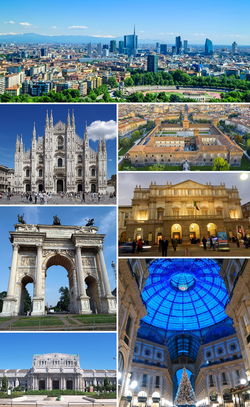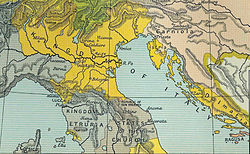Milan
Milan (Italian: Milano; ancient Medhelan Mediolanum (City in the middle of the lands)) is a city in northern Italy. Milan is the capital of the Metropolitan City of Milan (which replaced the Province of Milan) and of the Lombardy Region. It is populated by 1,371,498 inhabitants. It is the most populated province in Italy, and it is the second biggest city in Italy (after Rome).
|
Milano (Italian) | |
|---|---|
| Comune di Milano | |
 | |
| Coordinates: 45°28′01″N 09°11′24″E / 45.46694°N 9.19000°ECoordinates: 45°28′01″N 09°11′24″E / 45.46694°N 9.19000°E | |
| Country | |
| Region | |
| Metropolitan city | Milan (MI) |
| Government | |
| • Type | Strong Mayor–Council |
| • Mayor | Giuseppe Sala (EV) |
| • Legislature | Milan City Council |
| Area | |
| • Comune | 181.76 km2 (70.18 sq mi) |
| Elevation | 120 m (390 ft) |
| Population (1 January 2022)[1] | |
| • Comune | 1,371,498 |
| • Density | 7,545.65/km2 (19,543.2/sq mi) |
| • Metro | 4,336,121 |
| Time zone | UTC+1 (CET) |
| • Summer (DST) | UTC+2 (CEST) |
| Website | www.comune.milano.it |
Milan is the fashion capital of the world and its important influence on design, economics, opera, and the media make it amongst the world's top 18 Global cities, along with Moscow, Buenos Aires and Kuala Lumpur.
History
Mediolanum was founded by Insubres, a Celtic people. It was captured by the Romans in 222 BC. Milan became very successful under the Roman Empire.
Milan was ruled by the Spanish in the 1500s and the Austrians in the 1700s. During the Renaissance and the Romantic periods, Milan was a major cultural center in the whole of Europe, famous for its literature and opera.
During the war, the city was badly affected by Allied bombings and during the 50s and 60s the city grew into being the wealthy and industrial metropolis it is today.
Milan Media
Celtic finds dating back to the period preceding the Roman conquest (3rd-2nd century BC), which is preserved in the Civic Archaeological Museum of Milan
Roman ruins in Milan: the Columns of San Lorenzo
Remains of the Roman walls of Milan located inside the Civic Archaeological Museum of Milan
The Medieval Porta Ticinese (12th century) is one of the three medieval gates of the city that still exist in the modern Milan.
Piazza Mercanti used to be the heart of the city in the Middle Ages.
Spanish walls of Milan
Highlighted in yellow, the Napoleonic Kingdom of Italy, which had Milan as its capital
Popular print depicting the "Five Days of Milan" (18–22 March 1848) uprising against Austrian rule
References
- ↑ "Resident Population on 1st January: All Municipalities". I.Stat. OECD. Archived from the original on 16 May 2019. Retrieved 24 July 2022.
- ↑ "Database". ec.europa.eu. Eurostat. Archived from the original on 16 September 2015. Retrieved 8 January 2020. click General and regional statistics / Regional statistics by typology / Metropolitan regions / Demography statistics by metropolitan regions / Population on 1 January by broad age group, sex and metropolitan regions (met_pjanaggr3)
- ↑ In reference to the Meneghino mask.










